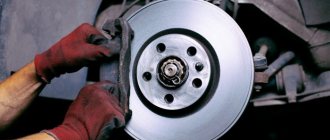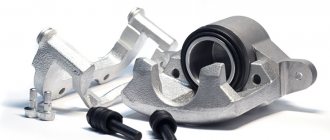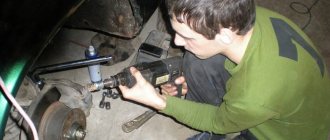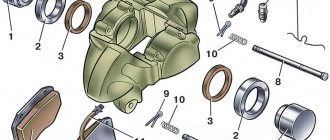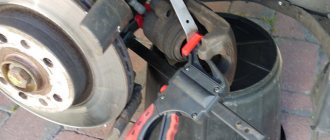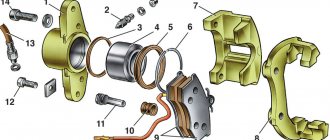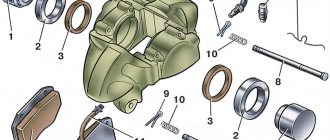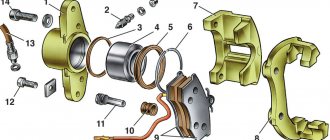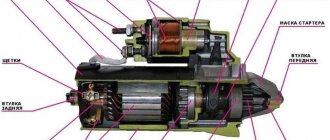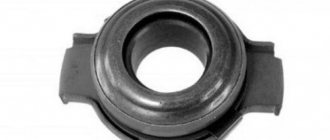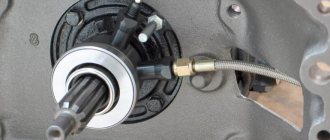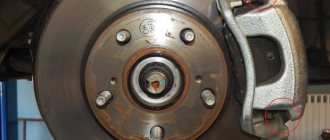Hi all! Any problems associated with the braking system of vehicles are potentially very dangerous. Therefore, every motorist should know why the brake caliper jams, what can provoke such a situation, how to diagnose and eliminate it. On your own or with the help of specialists, decide for yourself.
Our regular readers remember that we have previously talked about situations when the caliper knocks. Now let's consider a slightly different situation. Moreover, it is even more dangerous and unpredictable in terms of possible consequences if nothing is done after noticing the symptoms.
Let's start with the theory. The caliper on a car is part of the brake system. It is used in the design to press automobile brake pads when the corresponding pedal is pressed against the brake disc. As you understand, the node is extremely important.
But sometimes it can jam and creak because of this.
How to properly give way to pedestrians at intersections
- VAZ 2110;
- VAZ 2109;
- Lada Kalina;
- Chevrolet Lanos;
- Lada Priora;
- VAZ 2114;
- Chevrolet Niva;
- Lada Kalina;
- VAZ 2112;
- Daewoo Nexia;
- Volkswagen Polo Sedan;
- Skoda Octavia;
- Mercedes E class, etc.
Regardless of whether it is installed on a Niva or a BMW, the caliper must be in constant working order.
This is the direct task of the car owner himself. Or persons responsible for maintaining the machine and maintaining it in proper technical condition.
Before determining why it does not press out and what to do to prevent the car caliper from jamming, you need to understand the principle of its operation.
In optimal condition, when the brake assembly is working properly, the operating diagram looks like this:
- the driver presses the brake pedal;
- pressure is built up inside the braking system;
- this pressure is transmitted to the piston group of the auto calipers;
- the calipers, being under high pressure, bring the brake pads to the disc;
- the braking disc is attached to the car wheel;
- friction force arises;
- wheel rotation slows down;
- the car stops;
- or reduces the speed to the required values.
As you can see, in theory there is nothing complicated. But in fact, the caliper is rightly called an extremely complex element.
For the brakes to work effectively, it is important to ensure that the pad is parallel to the disc.
Friction during active braking causes heat production. This heats up the pad, brake fluid and our caliper.
Therefore, it is extremely necessary that the car caliper be made on the basis of a material that does not change its properties and characteristics during the process of strong heating. Plus, there are increased requirements for strength.
The hand (parking) brake cable is jammed.
Reasons: The braid is frayed inside or outside - this can be solved by replacing the cable. The return spring has weakened - this can be solved by replacing the spring with a new one. The mechanism of two return brackets has become sour and rusty - clean off the rust and spray with WD-40.
• A quick solution on the road is to return the cable to its original position by hitting the return bracket or spring with a hammer. You can check how the pads are wedged by turning the brake disc by hand. It should turn easily, but with a slight tightness. You can continue driving, but before replacing the cable or spring, DO NOT use the handbrake!
Traffic controller in pictures and with explanations: how to easily understand signals and gestures
It is the creaking that indicates that the element is seriously worn out. In the near future, the unit must be replaced without fail, which the car literally and figuratively screams about. It is extremely difficult not to hear such a creak. But for some reason, thousands of motorists still stubbornly ignore it. As a result, they pay a rather high price. Sometimes even to the point of road accidents resulting from brake failure while driving. To prevent this, you need to understand the issue and understand the essence of what is happening.
The first step is to look at the possible causes. In fact, there are several potential problems to look for. Some of them arise due to the fault of the motorist, others are caused by the natural process of wear and tear.
In any case, the appearance of a squeak as a symptom is a harbinger that at the most inopportune moment the caliper may simply jam.
If you know the reasons, you can prevent them and troubleshoot them by contacting a car service center or solving the problem yourself.
The reasons are:
- The brake pads were initially installed incorrectly. As a result, they are not strictly parallel to the response drives. Because of this, creaking often appears;
- The brake discs are seriously worn out. The reasons are natural wear and tear and aggressive use of the car;
- There is no lubrication in the unit. Initially there was little of it, or it was used up;
- The lubricant was selected incorrectly. Many people skimp on lubricant intended for calipers, hence the consequences.
The most undesirable and dangerous situation is rightly considered when the piston does not return and the unit begins to jam during operation.
Imagine that you are driving a car, press the brake, and then accelerate again. But at the same time, the calipers do not release the front brakes. Additional resistance arises, the car tries to move, but cannot. The result is uncontrolled braking, extremely intense wear and serious overheating of the entire system.
How to turn an inoperative brake cylinder piston into a functional one?
1) At the very beginning of the operation, you will need to remove the wheel from the car.
Note! By the way, when you remove the wheel from the car, try to spin it while it is in the air; if it slows down, then some piston has actually become unusable!
2) After your wheel is removed, immediately remove the caliper from the car after it in order to get out the brake piston that is not working. (For information on how to remove the brake caliper on front-wheel drive cars, see the article: “Replacing the brake caliper on a VAZ 2109”, and for information on how to remove this caliper on a classic, see “this article”)
3) Now, when the caliper is removed from the car, you will need to find a vice, or a very strong compressor, in order to remove the piston from the brake cylinder, so if you have a vice, then go to it and clamp the piston itself and behind the caliper after Once you clamp the piston, pull it, and thereby the piston will be removed from its installation location.
Note! If you don’t have a vice, then pick up a compressor or something else where air can come out under pressure and thereby insert the hose from the compressor into the small hole in the caliper, namely where you connect the brake hose itself and then turn on the compressor and the piston will fly out of its installation location!
What to do in such a situation
If you were able to diagnose creaking and signs of wedging in this unit, you need to perform a number of measures.
And here it is not necessary to contact a car service. You need:
- put the car on a jack;
- remove the wheel;
- unscrew the caliper;
- remove it;
- unscrew the problematic piston;
- remove the piston from the cylinder;
- visually inspect the element;
- check for chips, damage, corrosion;
- if there is rust, clean it;
- if severely damaged, replace;
- drain the working fluid from the element;
- remove the sealing ring;
- clean all surfaces;
- dry;
- fill in new hydraulics;
- assemble in reverse order.
When putting the assembly back together, pay special attention to not accidentally damage the old boot. If you notice cracks on it, then no restoration will help. Replacement only.
The brake caliper is stuck.
Reasons: mechanical particles or corrosion on the walls of the piston and cylinder interfere with the normal stroke of the piston - this can be solved by replacing it with a new unit or rebuilding the caliper using a repair kit.
• A quick solution on the road is to gently tap the caliper with a hammer through a piece of wood, 50/50, which will wedge it. Another option is to carefully try to insert a screwdriver between the pad and the disc, so that the pad moves away a little. It will be very difficult, but 50/50 it might work out.
How to determine the cause of the problem
Both an experienced car enthusiast and a novice driver can encounter a situation where a Granta wheel is jammed. To find the cause of the breakdown, it is necessary to remove the jammed wheel and diagnose all components of the rear brake system. You need to pay attention to the following nodes:
- brake pads;
- brake cylinder;
- wheel bearing;
- parking brake;
- calipers;
- hydraulic system.
If you can’t do this on your own, you should seek the help of car service specialists.
VAZ 2107 front brakes jam
- To the beginning of the forum
- Forum Rules
- Old design
- FAQ
- Search
- Users
it jammed a week ago.
The tires were heated up and smelled like burnt rubber. I took off the pads. moved the pistons back and forth 7 times on both sides. It's easy to walk on the left. It’s very heavy on the right, and it’s strange that one piston comes out and the other one comes out, as if the brake doesn’t go back. This was not the case on the left. Now it's jammed again. I filled the calipers and wheels with water. they hiss like irons. but he held out. A friend says the car is old (16 years old) and the cylinders need to be changed. I actually bought them already, but I don’t understand why then both wheels jam and not just the right one. Maybe there's something else there? and do I need to change all the brakes? Tell me the teapot.) Thanks in advance.
The pads are almost like new (less than a year old), the discs are also thick. I don’t know when the brake fluid was changed. but can it jam like that because of it? Here in Google it seems like they pulled up a frog? can she push like that? and where to look for it? The brake pedal has fairly decent free play.
how to adjust the extension of the vacuum rod? and which brake hose should I replace? or change all the rubber hoses in a row? here is an interesting quote: “There is an almost lethal scenario when the protrusion of the VU rod is greater than the recess of the GTZ piston, then your brakes jam, especially when the brake fluid has heated up and expanded.” similar to my case. ((because it doesn’t jam right away, but after a long ride
I just discovered that if you start the brake pedal with the brake pedal pressed, the pedal does not fall through, but presses a little and the pedal does not have free movement upward towards the frog
I just discovered that if you start the brake pedal with the brake pedal pressed, the pedal does not fall through, but presses a little and the pedal does not have free movement upward towards the frog
Q.E.D
It is adjusted like this: unscrew the two 13mm nuts that secure the GTZ to the body. Carefully pull the GTZ out of the hole in the vacuum chamber just enough so that you can get to the rod inside. The end of the rod is made with a 6mm turnkey (I think) - so it needs to be adjusted by twisting it in one direction or another. In your case, you need to tighten it a little clockwise. P.S. There is no need to change any hoses or tubes if nothing is leaking anywhere. I can adjust the rod without disconnecting the brake pipes. I don’t know how it will be for you. Good luck.
Which is what needed to be proven. It is adjusted like this: unscrew the two 13 nuts that secure the GTZ to the body. Carefully pull the GTZ out of the hole in the vacuum chamber just enough so that you can get to the rod inside. The end of the rod is made with a 6mm turnkey (I think) - so it needs to be adjusted by twisting it in one direction or another. In your case, you need to tighten it a little clockwise.
You can also simply unscrew the GTZ nuts, slightly move the vacuum seal, place washers on the studs, cutting them off in the shape of a crescent, so that the GTZ does not remove from the studs, and place the washers between the GTZ and the vacuum seal on the studs and tighten everything. You will get a small gap between the GTZ and the vacuum seal, and you don’t need anything remove and adjust. This is a temporary road option, but I drove it for more than 18,000 km and sold the car.
Source
Causes of automatic transmission jamming
An automatic transmission has little in common with a manual transmission, so the reasons for the wedge differ. Since this is a complex unit consisting of many different devices and mechanisms, anything can break in it. However, completely locked wheels are the result of only one malfunction - activated protection of the electronic unit.
Automatic transmission electronic unit
If any important component in the automatic transmission fails, the ECU recognizes it as a threat and, in order not to aggravate the situation and preserve other parts, completely blocks the transmission.
If we talk about jamming in gear, there are several reasons:
- Wear of the automatic transmission link. On the first automatic machines, the selector was connected to the transmission mechanically, through a slide. During operation, it, accordingly, wore out and failed, which made it difficult to move the lever and subsequently block it.
- Low pressure in the system. If the hydraulic pump fails or the oil level is low, the pressure in the system drops. Consequently, there will not be enough force to compress the clutch pack and the car will not move at all.
- Failure of sensors. Let's imagine that the car was moving in a certain gear. If any sensor fails, information stops flowing to the control unit and the automatic transmission does not respond to the speed of the car, and accordingly does not change gears.
These are the main reasons for automatic transmission jamming. But it is worth considering that if the electronic unit is damaged, it operates in emergency mode, that is, with the original parameters. Complete blocking is possible only in case of mechanical damage, so often no one experiences problems with this.
Rear wheel jams: we'll deal with the situation
10/14/2019 Issues discussed in the material:
- What to do if the rear wheel is stuck
- How to determine the cause of the problem
- Why, according to car enthusiasts, can the rear wheel suddenly jam?
Some motorists experience rear wheel jamming that occurs suddenly. And it’s good if the car is just starting to move. However, it is possible that the problem may arise while driving on the highway. This situation is highly likely to provoke an accident. What are the main reasons that lead to the rear wheel jamming? What should I do to successfully fix this problem? Let's look at these questions in this article.
How to spot an upcoming problem
It is necessary to pay attention to any deviations that go beyond the normal operation of the brake mechanisms. It is necessary to immediately check the condition of the brakes if there are any of the following signs:
- whistling, squeaking or grinding of brakes when braking;
- skidding or pulling the car to the side when braking;
- braking of one wheel when the brake pedal is released (this can occur even with adjusted wheel alignment and the same pressure in all tires);
- insufficient braking efficiency;
- brake pedal travel is too long;
- hum or howl from the front or rear suspension.
By knowing the signs of a faulty brake system, you can prevent more serious damage and avoid costly repairs.
